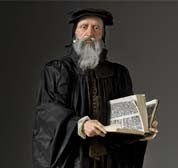Today in History: Groundhog Day
Groundhog Day, a holiday that, like so many American traditions, has roots in customs brought here by immigrants. Weather lore holds that if a groundhog emerges from his burrow on this day and sees his shadow, he will be frightened back into his home, and winter will last for six more weeks. But if it’s an overcast day, and he doesn’t see his shadow, spring will come early.
Why February 2? The day falls about halfway between the winter solstice (beginning of winter) and spring equinox (beginning of spring). Many ancient cultures observed rituals that marked the midseason. They also watched for the reappearance of hibernating animals, such as bears and badgers, as a natural sign that winter was coming to an end.
Early Christians observed February 2 as Candlemas, the day on which priests blessed candles and distributed them to the faithful. A superstition arose that if the weather was fair on Candlemas, the second half of the winter would be cold and stormy. “If Candlemas Day is bright and clear, there’ll be two winters in the year,” an old Scottish saying ran. In Germany, it was said that if Candlemas Day was bright enough to make a hedgehog cast a shadow, he would go back into hibernation until the spring equinox, meaning six more weeks of cold.
Many of Pennsylvania’s early settlers were Germans, and they brought the customer with them. By 1887, Groundhog Day had become an official celebration in the town of Punxsutawney. Every year, a groundhog named Punxsutawney Phil is pulled from his heated burrow so he can look for his shadow and predict the weather. Punxsutawney Phil is the nation’s most famous forecaster, but other groundhogs, such as General Beauregard Lee near Atlanta and Staten Island Chuck in New York City, help keep the tradition going strong.
American History Parade
1653 - New Amsterdam, later to became New York City, is incorporated.
1848 - The Treaty of Guadalupe Hidalgo ends the Mexican War.
1876 - Baseball’s National League is formed with eight teams.
1887 - The first official Groundhog Day is observed in Punxsutawney, Pennsylvania.
1940 - Frank Sinatra gets his big break when he debuts with the Tommy Dorsey Orchestra in Indianapolis.
The American Patriot's Almanac: Daily Readings on America
Labels: History





0 Comments:
Post a Comment
<< Home